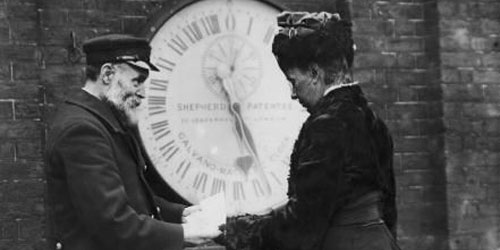Equipped with a pocket watch that was certified by the Greenwich Observatory every week, Ruth Belville sold the time to the clockmakers of London. She performed this duty between the years 1836 and 1840, helping these clockmakers set their products according to the watch, which was set to within a tenth of a second of Greenwich Mean Time. Belville is the subject of a new book, but mostly we just like calling her a Time Lady.
Two things to know about Belville’s silver pocket watch: because of its purpose as more than just a timekeeper and its special certification, it’s actually referred to as a chronometer. It was also named “Arnold,” after the man who created it for the Belvilles. Before Ruth took on the duties of selling the time, her parents, John and Maria (who took over for John after his death) were the ones selling the time. Their direct competition was the Standard Time Company, which provided time-keeping services using electricity and tried to derail the Belville’s more personal, old-fashioned service by spreading false information about the family, but failed to do so. Jerks.
The exact time was determined using the stars, which was best tracked by the Greenwich Observatory and the “time ball” that still drops at exactly 1:00 PM GMT every day. The book, Ruth Belville: The Greenwich Time Lady by David Rooney, outlines how important the Observatory was in Belville’s life and work, including how a French anarchist blew his hand off with a bomb intended for the Observatory while Belville had tea with some Greenwich timekeepers. (If it sounds familiar, it inspired the plot of Joseph Conrad‘s 1907 novel The Secret Agent.) But another interesting story involves how Jack the Ripper disrupted Belville’s business while he stalked the London streets.
That’s something to think about: the story of one woman who walked around London selling time that was determined by space. Where exactly do we write to Steven Moffat about this so he can create another mind-blowingly heartbreaking story for Doctor Who? Because the historical fan fiction is already starting in my head.
(The Telegraph via Neatorama)








Published: Sep 19, 2011 02:44 pm